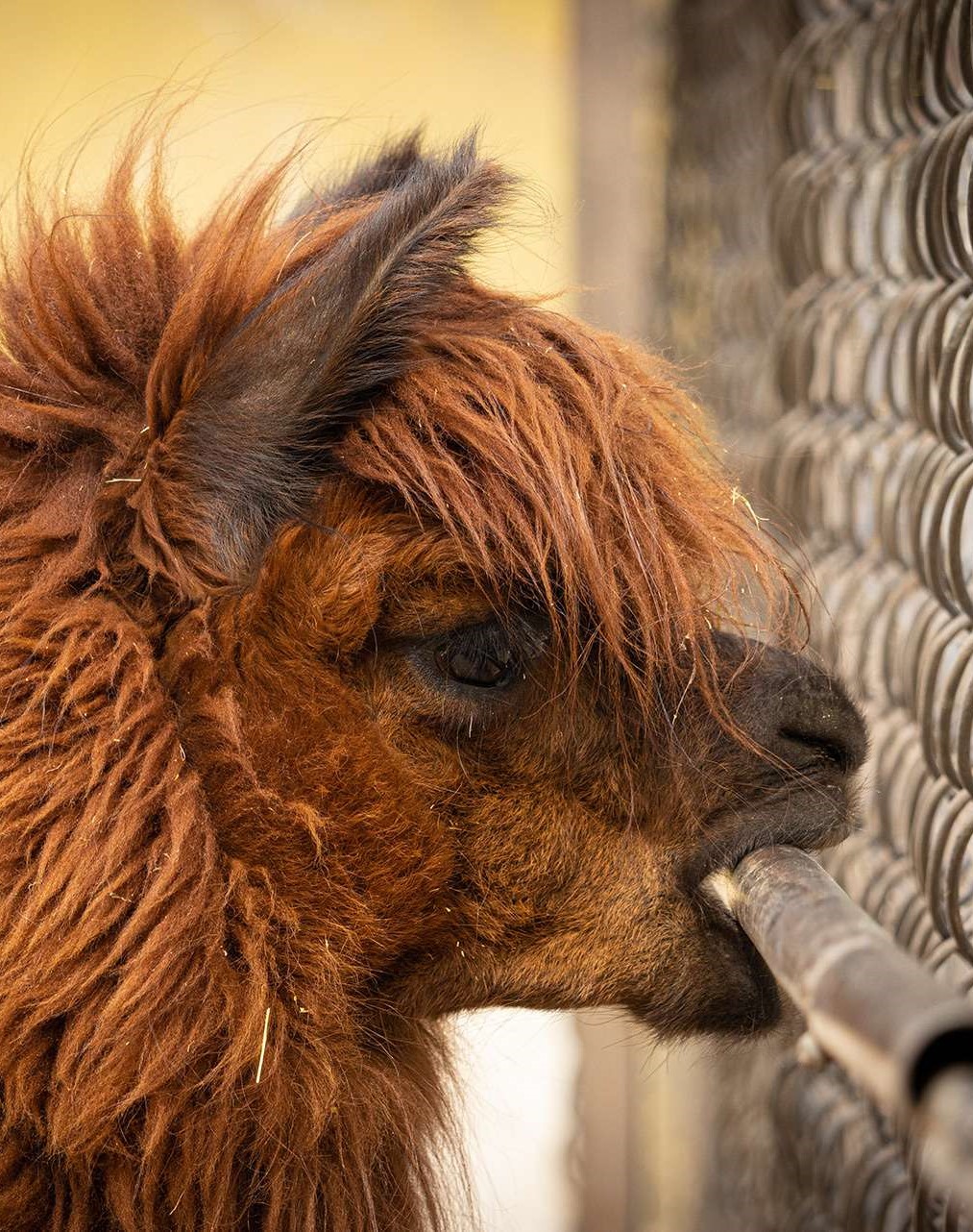Alpacas are strong and resilient animals but, like all others, they are susceptible to diseases, parasites, and bacteria. In most cases, a veterinarian can resolve issues and administer the prescribed treatments, but in some cases, it may not be possible to fully cure the animal. Constant monitoring of the health status of alpacas and the management and treatment of any diseases should be a priority in the management of these animals.
Intestinal parasites
Alpacas should be dewormed and vaccinated annually against clostridia. To reduce the likelihood of infestation and worsening health as well as the risk of disease, it is necessary to properly rotate pastures and use dry feeds. Symptoms such as anemia, weakening, and constant diarrhea indicate the presence of parasites, but targeted interventions can only be made through stool analysis.
Breeders should know which worms are present in the area to prepare the necessary measures in case alpacas are affected. Currently, there are no vaccines specifically developed against worms or antihelminthic products, so many drugs may not be effective. Fortunately, alpacas defecate together in the same places, so worm infestations are relatively rare.
If paddocks are too small or the forage is contaminated with parasite eggs, the likelihood of contracting worms increases. The life cycle of intestinal worms begins with the release of feces containing worm eggs on the ground. When the eggs hatch, the larvae on the grass are ingested by the alpacas, and in the intestine, the larvae reproduce, restarting the cycle with new feces.
Worm eggs are resistant to freezing and boiling, making them very difficult to eradicate. It is important to disinfect defecation sites with lime, creolin, and similar substances, with thorough mechanical cleaning. Alpacas must be treated with drugs to kill adult worms, but it is important that antihelmintics, being toxic, are administered in the prescribed doses.
Treatments against worms should be repeated twice a year, as often some worms survive the first treatment. The choice of drug for worm treatment should be made by a veterinarian.
It is essential to disinfect defecation areas with lime, creolin, and similar substances, along with thorough mechanical cleaning, to maintain the health of alpacas and prevent diseases. Alpacas must be treated with medications to kill adult worms, but it is crucial that anthelmintics, being toxic, are administered in the prescribed doses. Treatments against worms should be repeated twice a year, as often some worms survive the first treatment. The choice of medication for worm treatment must be made by a veterinarian.
- Strongyles,responsible for gastritis;
- Trichuris;
- Moniezia tapeworms, which live in the intestines;
- Dictyocaulus and fly larvae that reside in the nose;
- Fasciola that attack the liver;
Thelazia of the eyes.

The presence of other grazing animals increases the likelihood of contracting worms, and the prolonged stay of alpacas in the same paddock is also detrimental as feces are spread through movement. By keeping paddocks clean and adopting the described hygienic and pharmaceutical measures, infections from coccidia such as Eimeria species, which cause aggressive diarrhea especially in cria, can be prevented.
Mites
Mites are parasites and mainly come in three types: the scabies mite (Sacropets scabiei), Choriopets species, and Psoropets species. Typically, mites do not affect the entire herd but only certain individuals, and treatments to eradicate them are not always successful.
Alpacas are susceptible to infestations of blood-sucking lice, while ticks rarely manage to settle on the animal due to its thick wool; however, they sometimes establish themselves in the ears, from which they can be removed using insecticides, ivermectin, or tweezers. It’s very important to monitor alpacas for infestations to protect their health and to prevent damage to the fiber of their fleece.
Scabies Mite
The scabies mite is the most common and lives in the host’s skin, measuring about 0.4 mm, thus invisible to the naked eye. Alpacas affected by this parasite exhibit redness, hair loss starting from the legs, papules, and pustules. The most affected areas are between the toes, at the extremities of the limbs, on the chest, abdomen, thighs, armpits, the perineum of females, and the prepuce of males.
Treatment
Scabies mites can be observed through deep skin scrapings. The treatment used to eradicate this mite is ivermectin at 0.2 mg/kg administered subcutaneously every 10 days.
Chorioptes species
The Chorioptes species mite is similar to the scabies mite, except that it lives on the surface of the animal’s skin and not subcutaneously.
Treatment
To eliminate this mite, medications are used on the affected areas (combining DMSO/ivermectin – 10mg per 1 ml).
Psoroptes species
The Psoroptes species mite is responsible for mange, which lives on the alpaca’s skin; eggs are laid near the lesions and hatch in 3 days.
The most affected areas are the ears, causing the animal to shake its head, display uncoordinated movements, and secrete waxy substances in the ears.
Treatment
The treatment used to eradicate the Psoroptes species mite involves administering ivermectin through subcutaneous injections. It is important to administer three doses 10 days apart, treating all animals.
In this case, it is important to administer three doses at intervals of 10 days apart, treating all the animals involved.

Eczema facciale
Facial eczema is a condition that irreparably compromises the health of alpacas, caused by the toxin sporidesmin from the fungus Pithomyces chartarum. Symptoms can include agitation, skin swelling, and crusting, reduced birth rates, and abortions, though often no symptoms are evident until the damage is severe.
Facial eczema can be diagnosed in a living animal by checking the level of the enzyme gamma-glutamyltransferase (GGT), released by damaged biliary cells and the liver. In deceased animals, liver analysis under a microscope will show evident lesions. Alpacas with mild symptoms can be treated with supportive remedies and shade (complete darkness is preferable).
The damage from the toxin to the liver can be reduced by using zinc, administered at 2 grams per 100 kg of weight per day. The recommended administration for alpacas is from January to April, with a break of at least 100 days.
Prevention
To prevent facial eczema, it is necessary to monitor the level of spores and act in case of an excess deemed a danger to alpacas. To reduce the presence of spores in the pasture, organic material should be quickly removed as its decomposition would facilitate the proliferation of the fungus. Fungicides can be used to provide protection for about 8 weeks, although they do not entirely eliminate the spores.
Carenza di rame
Copper deficiency is a well-known side effect from a diet containing zinc. Since administering supplements and copper injections can be very painful and even fatal, extreme precision and caution are essential. Treatments should only be administered to animals diagnosed with this deficiency by a veterinarian and not as a preventive measure nor to the entire herd. Proper diet plays a crucial role in preventing diseases and other serious health issues.
Tuberculosis
Alpacas are highly resistant to tuberculosis, caused by Mycrobacterium bovis and other microbes. Since they are not intended for human consumption, tuberculosis tests (TBC) are not mandatory. Testing is necessary when animals participate in shows (no more than 2 months prior to the event), travel frequently, during the sale and purchase if a new specimen is introduced into the herd, or if there are other animals in the farm susceptible to TBC. However, it’s advisable to perform random testing even if these conditions do not apply.
Rickets
Rickets is a disease that makes bones fragile and weak due to a calcification defect. Symptoms include painful limbs, frequent fractures, thin and curved bones; the animal walks little and appears tired and listless. Rickets is generally caused by a deficiency of vitamin D and calcium phosphate.
Vitamin D is crucial for alpacas, synthesized through sunlight exposure, and helps absorb phosphate. Alpacas are prone to rickets because they genetically do not produce enough vitamin D. This deficiency is likely due to less sunlight exposure in farms far from their country of origin, where the duration of daylight hours is shorter and the atmosphere less rarefied. Also, alpaca wool blocks UV rays, necessitating shearing the herd in spring.
Prevention
To prevent rickets in alpacas and ensure good health, avoiding the onset of other diseases, it’s necessary to administer vitamin A, D, and E injections in autumn, winter, and spring. The injections should be carried out approximately every 3 or 4 months and also help prevent infertility and miscarriages. In cases of hypophosphatemic rickets, therapy involves administering inorganic phosphate salts and vitamin D metabolites, such as calcitriol, until growth completion.
Many factors can trigger diseases, maladies, and infestations. Some are influenced by external factors that can be preemptively managed, while others, such as origin and anatomy, play a fundamental role and cannot be directly intervened (at least not directly).
